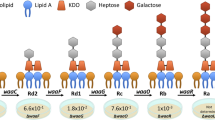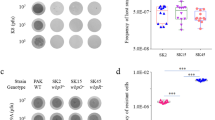Summary.
Mammals have become “an environment” for enterobacterial phage life cycles. Therefore it could be expected that bacteriophages adapt to them. This adaptation must comprise bacteriophage proteins.
Gp Hoc seems to have significance neither for phage particle structure nor for phage antibacterial activity. It is evidently not necessary for the “typical” antibacterial actions of bacteriophages. But the rules of evolution make it improbable that gp Hoc really has no function, and non-essential genes of T4-type phages are probably important for phages’ adaptation to their particular lifestyle. More interesting is the eukaryotic origin of gp Hoc: a resemblance to immunoglobulin-like proteins that reflects their evolutionary relation. Substantial differences in biological activity between T4 and a mutant that lacks gp Hoc were observed in a mammalian system. Hoc protein seems to be one of the molecules predicted to interact with mammalian organisms and/or modulate these interactions.
Similar content being viewed by others
References
A Bateman SR Eddy VV Mesyyanzhinov (1997) ArticleTitleA member of the immunoglobulin superfamily in bacteriophage T4. Virus Genes 14 163–165 Occurrence Handle10.1023/A:1007977503658 Occurrence Handle1:CAS:528:DyaK2sXksFCnsbs%3D Occurrence Handle9237357
KS Childs S Goodbourn (2003) ArticleTitleIdentification of novel co-repressor molecules for interferon regulatory factor-2. Nucleic Acid Res 31 3016–3026 Occurrence Handle1:CAS:528:DC%2BD3sXks1WqtLc%3D Occurrence Handle12799427
AM Comeau HM Krisch (2005) ArticleTitleWar is peace – dispatches from the bacterial and phage killing. Curr Opinion Microbiol 8 488–494 Occurrence Handle1:CAS:528:DC%2BD2MXmvVCmsLY%3D
Dabrowska K, Opolski A, Wietrzyk J, Nevozhay D, Szczaurska K, Switala-Jelen K, Gorski A (2005) Activity of bacteriophages in murine tumour models depends on the route of phage administration. Oncol Res 15: (in press)
K Dabrowska A Opolski J Wietrzyk K Switala-Jelen J Boratynski A Nasulewicz L Lipinska A Chybicka M Kujawa M Zabel B Dolinska-Krajewska E Piasecki B Weber-Dabrowska J Rybka J Salwa E Wojdat M Nowaczyk A Gorski (2004) ArticleTitleAntitumour activity of bacteriophages in murine experimental cancer models caused possibly by inhibition of β3 integrin signaling pathway. Acta Virol 48 241–248 Occurrence Handle1:CAS:528:DC%2BD2MXjsFaktbw%3D Occurrence Handle15745047
K Dabrowska A Opolski J Wietrzyk K Switala-Jelen J Godlewska J Boratynski D Syper B Weber-Dabrowska A Gorski (2004) ArticleTitleAnticancer activity of bacteriophage T4 and its mutant HAP1 in mouse experimental tumour models. Anticancer Res 24 3991–3995 Occurrence Handle1:CAS:528:DC%2BD2MXitFylt74%3D Occurrence Handle15736444
K Dabrowska K Switała-Jelen A Opolski B Weber-Dabrowska A Gorski (2005) ArticleTitleBacteriophage penetration in vertebrates. J Appl Microbiol 98 7–13 Occurrence Handle10.1111/j.1365-2672.2004.02422.x Occurrence Handle1:STN:280:DC%2BD2cnjsFSmtw%3D%3D Occurrence Handle15610412
Dąbrowska K, Zembala M, Boratyński J, Kujawa M, Switała-Jeleń K, Wietrzyk J, Szczaurska K, Opolski A, Górski A (2005) Antimetastatic activity of bacteriophage HAP1 and its genetic characteristics. 1st Vienna Meeting on Tumor Invasion and Metastasis: Bridging Basic and Clinical Research, March 11–15, 2005. Vienna/Brunn am Gebirge, Austria, Abstract Book (2005), pp 46
C Desplats HM Krisch (2003) ArticleTitleThe diversity and evolution of T4-type bacteriophages. Res Microbiol 154 259–267 Occurrence Handle10.1016/S0923-2508(03)00069-X Occurrence Handle1:CAS:528:DC%2BD3sXkt1ymurw%3D Occurrence Handle12798230
A Fokine PR Chipman PG Leiman VV Mesyanzhinov VB Rao MG Rossmann (2004) ArticleTitleMolecular architecture of the prolate head of bacteriophage T4. Proc Natl Acad Sci USA 101 6003–6008 Occurrence Handle10.1073/pnas.0400444101 Occurrence Handle1:CAS:528:DC%2BD2cXjsFKnsb4%3D Occurrence Handle15071181
A Gorski K Dabrowska K Switala-Jelen M Nowaczyk B Weber-Dabrowska J Boratynski J Wietrzyk A Opolski (2003) ArticleTitleNew insights into the possible role of bacteriophages in host defense and disease. Med Immunol 2 2 Occurrence Handle10.1186/1476-9433-2-2 Occurrence Handle12625836
Gorski A, Kniotek M, Perkowska-Ptasinska A, Mroz A, Przerwa A, Gorczyca W, Dabrowska K, Weber-Dabrowska B, Nowaczyk M (2005) Bacteriophages and transplantation tolerance. Transplant Proc (in press)
A Gorski M Nowaczyk B Weber-Dabrowska M Kniotek J Boratynski A Ahmed K Dabrowska P Wierzbicki K Switala-Jelen A Opolski (2003) ArticleTitleNew insights into the possible role of bacteriophages in transplantation. Transplant Proc 35 2372–2373 Occurrence Handle10.1016/S0041-1345(03)00811-X Occurrence Handle1:STN:280:DC%2BD3svmvVyqsQ%3D%3D Occurrence Handle14529945
K Iwasaki BL Trus PT Wingfield N Cheng G Campusano VB Rao AC Steven (2002) ArticleTitleMolecular architecture of bacteriophage T4 capsid: vertex structure and bimodal binding of the stabilizing accessory protein. Soc Virol 271 321–333
Karam JD (1994) Molecular biology of bacteriophage T4. American Society for Microbiology, Washington D.C.
Kniotek M, Ahmed AMA, Dabrowska K, Switala-Jelen K, Weber-Dabrowska B, Boratynski J, Nowaczyk M, Opolski A, Górski A (2004) Bacteriophage interactions with T cells and platelets. In: Immunology 2004, cytokine network, regulatory cells, signalling, and apoptosis. Monduzzi Editors, Bologna, Italy, pp 189–193
PG Leiman S Kanamaru VV Mesyanzhinov F Arisaka MG Rossmann (2003) ArticleTitleStructure and morphogenesis of bacteriophage T4. Cell Mol Life Sci 60 2356–2370 Occurrence Handle1:CAS:528:DC%2BD2cXjvFelsrg%3D Occurrence Handle14625682
CR Merril B Biswas RM Carlton NC Jensen GJ Creed S Zullo S Adhya (1996) ArticleTitleLong-circulating bacteriophage as antibacterial agents. Proc Natl Acad Sci USA 93 3188–3192 Occurrence Handle10.1073/pnas.93.8.3188 Occurrence Handle1:CAS:528:DyaK28XisVWisrw%3D Occurrence Handle8622911
CR Merril D Scholl SL Adhya (2003) ArticleTitleThe prospect for bacteriophage therapy in Western medicine. Nat Rev Drug Discov 2 489–497 Occurrence Handle10.1038/nrd1111 Occurrence Handle1:CAS:528:DC%2BD3sXktFOhu7g%3D Occurrence Handle12776223
K Switala-Jelen K Dabrowska A Opolski L Lipinska A Gorski (2004) ArticleTitleThe biological functions of β3 integrins. Folia Biol (Praha) 50 143–152 Occurrence Handle1:CAS:528:DC%2BD2MXivF2l
Author information
Authors and Affiliations
Rights and permissions
About this article
Cite this article
Dąbrowska, K., Świtała-Jeleń, K., Opolski, A. et al. Possible association between phages, Hoc protein, and the immune system. Arch Virol 151, 209–215 (2006). https://doi.org/10.1007/s00705-005-0641-7
Received:
Accepted:
Published:
Issue Date:
DOI: https://doi.org/10.1007/s00705-005-0641-7




